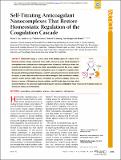| dc.contributor.author | Lin, Kevin Yu-Ming | |
| dc.contributor.author | Lo, Justin H. | |
| dc.contributor.author | Consul, Nikita | |
| dc.contributor.author | Kwong, Gabriel A. | |
| dc.contributor.author | Bhatia, Sangeeta N. | |
| dc.date.accessioned | 2015-11-10T14:44:05Z | |
| dc.date.available | 2015-11-10T14:44:05Z | |
| dc.date.issued | 2014-08 | |
| dc.date.submitted | 2014-02 | |
| dc.identifier.issn | 1936-0851 | |
| dc.identifier.issn | 1936-086X | |
| dc.identifier.uri | http://hdl.handle.net/1721.1/99874 | |
| dc.description.abstract | Antithrombotic therapy is a critical portion of the treatment regime for a number of life-threatening conditions, including cardiovascular disease, stroke, and cancer; yet, proper clinical management of anticoagulation remains a challenge because existing agents increase the propensity for bleeding in patients. Here, we describe the development of a bioresponsive peptide–polysaccharide nanocomplex that utilizes a negative feedback mechanism to self-titrate the release of anticoagulant in response to varying levels of coagulation activity. This nanoscale self-titrating activatable therapeutic, or nanoSTAT, consists of a cationic thrombin-cleavable peptide and heparin, an anionic polysaccharide and widely used clinical anticoagulant. Under nonthrombotic conditions, nanoSTATs circulate inactively, neither releasing anticoagulant nor significantly prolonging bleeding time. However, in response to life-threatening pulmonary embolism, nanoSTATs locally release their drug payload and prevent thrombosis. This autonomous negative feedback regulator may improve antithrombotic therapy by increasing the therapeutic window and decreasing the bleeding risk of anticoagulants. | en_US |
| dc.description.sponsorship | National Institutes of Health (U.S.) (R01CA124427-01) | en_US |
| dc.description.sponsorship | National Cancer Institute (U.S.) (U54CA119349) | en_US |
| dc.description.sponsorship | National Cancer Institute (U.S.) (U54CA119335) | en_US |
| dc.description.sponsorship | National Cancer Institute (U.S.) (Center of Cancer Nanotechnology Excellence at MIT-Harvard U54CA151884) | en_US |
| dc.description.sponsorship | David & Lucile Packard Foundation (Fellowship) | en_US |
| dc.description.sponsorship | David H. Koch Institute for Integrative Cancer Research at MIT (Marie D. and Pierre Casimir-Lambert Fund) | en_US |
| dc.description.sponsorship | National Cancer Institute (U.S.) (Koch Institute Support (Core) Grant P30-CA14051) | en_US |
| dc.description.sponsorship | MIT-Harvard Center of Cancer Nanotechnology Excellence (5 U54 CA151884-03) | en_US |
| dc.description.sponsorship | National Institutes of Health (U.S.). Medical Scientist Training Program (T32GM007753) | en_US |
| dc.description.sponsorship | National Institutes of Health (U.S.) (Ruth L. Kirschstein National Research Service Award F32CA159496-02) | en_US |
| dc.description.sponsorship | Burroughs Wellcome Fund (Career Award at the Scientific Interface) | en_US |
| dc.language.iso | en_US | |
| dc.publisher | American Chemical Society (ACS) | en_US |
| dc.relation.isversionof | http://dx.doi.org/10.1021/nn501129q | en_US |
| dc.rights | Article is made available in accordance with the publisher's policy and may be subject to US copyright law. Please refer to the publisher's site for terms of use. | en_US |
| dc.source | ACS | en_US |
| dc.title | Self-Titrating Anticoagulant Nanocomplexes That Restore Homeostatic Regulation of the Coagulation Cascade | en_US |
| dc.type | Article | en_US |
| dc.identifier.citation | Lin, Kevin Y., Justin H. Lo, Nikita Consul, Gabriel A. Kwong, and Sangeeta N. Bhatia. “Self-Titrating Anticoagulant Nanocomplexes That Restore Homeostatic Regulation of the Coagulation Cascade.” ACS Nano 8, no. 9 (September 23, 2014): 8776–8785. © 2014 American Chemical Society | en_US |
| dc.contributor.department | Harvard University--MIT Division of Health Sciences and Technology | en_US |
| dc.contributor.department | Massachusetts Institute of Technology. Department of Chemical Engineering | en_US |
| dc.contributor.department | Massachusetts Institute of Technology. Department of Electrical Engineering and Computer Science | en_US |
| dc.contributor.department | Koch Institute for Integrative Cancer Research at MIT | en_US |
| dc.contributor.mitauthor | Lin, Kevin Yu-Ming | en_US |
| dc.contributor.mitauthor | Lo, Justin H. | en_US |
| dc.contributor.mitauthor | Consul, Nikita | en_US |
| dc.contributor.mitauthor | Kwong, Gabriel A. | en_US |
| dc.contributor.mitauthor | Bhatia, Sangeeta N. | en_US |
| dc.relation.journal | ACS Nano | en_US |
| dc.eprint.version | Final published version | en_US |
| dc.type.uri | http://purl.org/eprint/type/JournalArticle | en_US |
| eprint.status | http://purl.org/eprint/status/PeerReviewed | en_US |
| dspace.orderedauthors | Lin, Kevin Y.; Lo, Justin H.; Consul, Nikita; Kwong, Gabriel A.; Bhatia, Sangeeta N. | en_US |
| dc.identifier.orcid | https://orcid.org/0000-0001-5981-2589 | |
| dc.identifier.orcid | https://orcid.org/0000-0002-1293-2097 | |
| dspace.mitauthor.error | true | |
| mit.license | PUBLISHER_POLICY | en_US |
| mit.metadata.status | Complete | |
